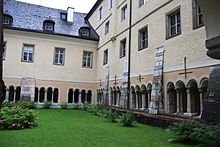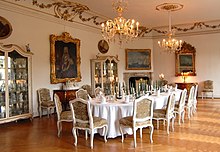Royal Berchtesgaden Castle

The Berchtesgaden Royal Castle is a former Augustinian canons building in Berchtesgaden , the beginnings of which date back to around 1102 and which, after several renovations, also served as the residence of the prince provost of Berchtesgaden . From 1810 it was owned by the Bavarian royal family and is now owned by the Wittelsbach Compensation Fund .
history
The beginnings
Countess Irmingard von Sulzbach vowed to found an Augustinian canon . In the year of her death, her son Berengar I von Sulzbach, together with Eberwin, was the first provost to begin building it in 1101. Starting with up to seven canons (the first from Rottenbuch in the Allgäu ), Eberwin initiated clearing and gradually expanded the monastery. In 1122, under his aegis, a construction phase or “emergency building” of the collegiate church of St. Peter and John the Baptist, which is part of today's palace ensemble, was consecrated by Archbishop Konrad of Salzburg . After his death in the second half of the 12th century, this was followed by a more massive construction as a three-aisled Romanesque pillar basilica and probably also the first towers, of which there is neither a description nor an illustration.
In the following centuries, the adjacent monastery buildings were also continuously expanded. On the east side of the building built in 1180 Romanesque cloister one was two-aisled Gothic hall. It was followed by Renaissance halls around 1500 on the south side . In 1725 the baroque south wing was built. Since the canons never had enough money to dismantle everything at once and erect a completely new building, the different parts of the building have been preserved to this day.
As the seat of abbey and prince provosts with increasing abundance of power , the parts of the building that were not explicitly determined spiritually functioned as the secular residence of a sovereign state over the Berchtesgadener Land , which, from 1559 onwards to the prince-provost of Berchtesgaden , was an independent, imperial principality until the secularization of 1803 .
→ See also historical sections : Prince Provosts Berchtesgaden and Berchtesgaden
Hunting lodge of the Bavarian kings
After the secularization in 1803 and the associated end of the provincial rule, the state of Berchtesgaden was first incorporated into the newly founded Electorate of Salzburg , from 1805 to the Austrian Empire and for a short time in 1809 Napoleon's France . In 1810 the Kingdom of Bavaria finally came into being.
In 1818 the oldest part of the palace was set up as a summer residence for King Maximilian I , while the first and second floors and the archive building were leased to the regional court until 1828. In addition to Maximilian I, the Bavarian kings Ludwig I and Maximilian II , who succeeded him, and who also had the royal villa built in Berchtesgaden , and in particular the Prince Regent Luitpold and his son King Ludwig III. often in the former pen.
After losing his right to the throne in the course of the November Revolution in 1918 , Crown Prince Rupprecht of Bavaria and his family moved into the castle in Berchtesgaden. Their stay lasted from 1922 to 1933 and three of his children were born there.
In addition to its partial use as a publicly accessible museum (see the following sections), the castle is currently sometimes used as a secondary residence for Rupprecht's grandson Franz Duke of Bavaria .
Museums
Castle Museum
Spaces
Crown Prince Rupprecht made the palace accessible to the public. 30 of 120 rooms are still shown today. Rupprecht furnished them with original furniture, tapestries and paintings from the respective time. Three richly stocked armories show hunting rifles and pistols from three centuries. Drinking feathers , halberds and partisans flank high quality armor .
Special pieces of furniture are also waiting for the visitor. The so-called song table from 1591 is a table with a tabletop made of Solnhofen stone and processed with nitric acid . On the table top is a six-part motet from Palestrina , the Passion of Christ, a perpetual calendar, allegories of the planets and the coat of arms of the Wittelsbach family.
A baroque writing cabinet from 1750 is known as a convict cabinet . The carpenter Johann Georg Wahl made it for Elector Karl Theodor von der Pfalz after he had sentenced him to prison for misusing the Electoral Seal. The cupboard was supposed to obtain a pardon from Wahl. It contains 72 drawers, two of which are secret drawers. He is with inlays of mother of pearl , ivory , ebony decorated and colored wood.
In the palace, in the former living quarters of Crown Prince Rupprecht, there is the large dining room , in which the valuable Nymphenburg porcelain is used as decoration. One can see a centerpiece from 1755, which is supposed to represent the Nymphenburg palace gardens . When the centerpiece was first presented it was such an attraction that the valuable porcelain had to be guarded by guards.
In addition to the furniture, many works of art and paintings can be viewed in the palace, including valuable works by famous artists such as Tilman Riemenschneider , Veit Stoss , Peter Gertner , Barthel Beham and paintings from the Munich School .
In summer, when the weather is nice, you can also visit the small rose garden.
guides
The rooms can only be viewed as part of a guided tour that extends over 30 rooms. These are offered all year round. Before and around Christmas, Berchtesgaden Castle offers evening tours. The glow of dimmed chandeliers and up to 800 candles gives the visitor a special atmosphere. A couple of surprises await the visitor during the tour. In the run-up to Christmas there are special Advent tours with Christmas texts and singing. Berchtesgaden Castle also offers a music tour, during which a singer performs suitable music in different rooms, making the museum visit seem more lively. Pieces from Mozart to Sinatra are on offer .
Deer Museum
The deer museum has been housed in the stables of the castle since 2005 . It was built under the direction of the hunting historian Bernd E. Ergert . Especially for hunting and nature lovers, it offers an interesting insight into wildlife science.
Trivia
In 1952, the Traunstein district court conducted the nationwide sensational "Küßwetter trial" in the castle. The forester Georg Küßwetter and other foresters were accused of setting fire to several alpine huts and blowing up the former fortified building under the Blaueis Glacier . Küßwetter's instigation of these crimes was not least due to his hostility towards tourists, since in the case of the Wehrmacht House he wanted to prevent the Alpine Club from using it as a new Blaueishütte .
Web links
Individual evidence
- ↑ Manfred Feulner : Berchtesgaden - history of the country and its inhabitants . P. 18
- ↑ A. Helm: Berchtesgaden in the course of time , keyword: Geschichte des Landes, pp. 106 to 111, pp. 107–108.
- ↑ A. Helm: Berchtesgaden through the ages . Keyword: Collegiate Church p. 338 f.
- ↑ Dieter Meister: The haven of calm for kings, artists, coffee drinkers and children . In: Berchtesgadener Anzeiger, without date
- ↑ Hellmut Schöner (ed.), A. Helm : Berchtesgaden in the course of time . Keyword: Castle p. 310
- ↑ The site is finally avalanche-proof . ( Memento of the original from August 19, 2009 in the Internet Archive ) Info: The archive link was inserted automatically and has not yet been checked. Please check the original and archive link according to the instructions and then remove this notice. In: Süddeutsche Zeitung , August 9, 2009, on the paragraph "Küßwetter"
- ↑ Schaun's in Ramsau . In: Der Spiegel . No. 32 , 1952 ( online ).
- ↑ To document the process date, quote from Hellmut Schöner: Berchtesgaden Alps: Mountain Guide for Hikers and Mountaineers, p. 105 above
Coordinates: 47 ° 37 '59.8 " N , 13 ° 0'11" E


